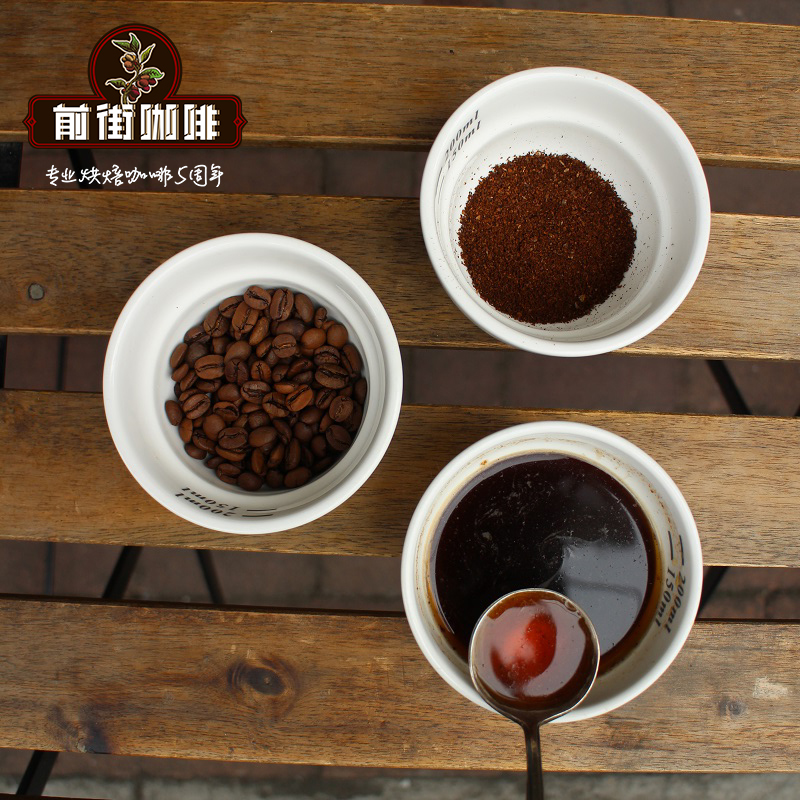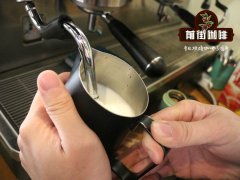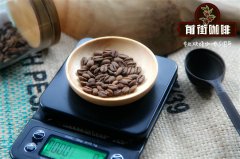The classification of Kenyan coffee raw beans there are differences in flavor between Kenyan coffee varieties, garden beans and flat beans.

Professional coffee knowledge exchange more coffee bean information please follow the coffee workshop (Wechat official account cafe_style)
The grading of raw coffee beans in Kenya? What are the coffee producing areas in Kenya? How do Kenyan beans taste sour?
Kenya, located in East Africa, is one of the major coffee producing countries. More than 6 million people in the country are engaged in the coffee industry, mostly in the form of a combination of small farmers and cooperatives.
Coffee trees in Kenya are mostly planted at 1400 m-2000 m above sea level, and the growth areas include Ruiri, Thika, Kirinyaga and Mt. Kenya West, Nyeri, Kiambu and Muranga.
There are many producing areas in Kenya that strive to preserve the native forest ecosystem, protect the natural gene pool, support the reproduction of wild coffee varieties and breed a variety of coffee trees.
In 1930, the unique Kenyan varieties SL28 and SL34, which were cultivated and named by the "Scott Laboratories" laboratory, were born under such a good environment.
According to botanists in SL laboratory, SL28 and SL34 are genetic variants.
Among them, SL28 has a mixed pedigree of French missionaries, mocha and Yemeni Tibica. The goal of cultivating SL28 was to mass produce coffee beans with high quality and resistance to diseases and insect pests. Although SL28 did not produce as much as expected, copper and broad bean-shaped beans have great sweetness, balance and complex flavor, as well as significant citrus and black plum characteristics.
SL34 is similar to SL28 in flavor, with a heavier, fuller and cleaner finish than SL28, except for the complex acidity and great sweetness of the finish. SL34 beans are similar to SL28 in appearance, but are more adaptable to sudden heavy rain. It is these two important varieties that lead us to the unique Kenyan style: strong acidity, rich taste and beautiful balance.
Flavor description: little Cranberry Juice, BlackBerry, dried raisins, cloth, round brown body
There are many kinds of coffee, and each has its own grade. If you want to have a cup of coffee, there are many different choices. Among them, beans in the same producing area are divided into several grades, and consumers who do not have a clear understanding of this will look a little dizzy, so the editor collected some grading information about Kenyan coffee beans to share with you.
As for the distinction of quality, Kenya uses the digital grading method to distinguish the quality of coffee, but this digital grading method is not much publicized, so few people know about it. Therefore, the classification is based on particles, and the PB with different shapes is about the same as AA, but if it is manor or +, it is two or one grade respectively. For example, AB manor beans are about the same as AA+ and PB+.
The coffee grading system in Kenya is under the policy of government-led management of quality and guidance to coffee farmers.
The Kenya Coffee Agency, an official unit set up by the government after the coffee is harvested, is established.
(Coffee Board of Kenya referred to as CBK), founded in 1933, in the capital Nairobi
(Nairobi) Coffee Exchange (the Nairobi Coffee Exchange) conducts weekly
A regular auction, an auction system managed by the government as a whole, according to the grading system
Taking "particle size", weight, shape and appearance as the standard is the basis for the main auction price.
The official grading system for raw beans in Kenya is as follows:
Class E (elephant beans):
This grade is the largest grain grade of Kenyan coffee beans, above 18 mesh (18 + 64 "), also known as
The quantity of elephant beans is so small that this grade of goods can hardly be seen in the Taiwan market.
AA level:
Particle size (Screen Size) between 17 and 18 meshes (7.20mm sieve)
AB level:
Particle size (Screen Size) is between 15 and 16 meshes (6.8mm--6.2mm sieve)
Accounts for the majority of output, and is also the most common grade of raw beans.
PB level:
Round raw beans, accounting for about 10% of all coffee beans
Level C:
Particle size (Screen Size) between 12 and 14 meshes (4.8mm--5.6mm sieve)
TT level:
From AA and AB grade beans, lighter raw beans blown by an airflow filter
It means that the bean is soft and the hardness is not up to standard.
Level T:
Particle size (Screen Size) less than 12 mesh size (4.8mm screen)
From C-grade beans, the lighter beans are blown out with an airflow filter.
It means that the beans are soft, the hardness is not up to standard, and they are small particles, containing some broken and defective beans.
MH/ML level:
Beans that have not been washed and have not been selected because they have been harvested
Falling beans, accounting for about 7% of all coffee beans, belong to the lowest grade beans, only for
Kenyan domestic demand market.
In addition to the above Kenyan national official grading system, other private companies Kenyan exporters
Or raw bean traders, for AA and AB grades of coffee, raw beans are added to the private sector.
Special classification (not officially recognized by Kenyan countries), common ones are: AA TOP,AA+ (plus)
AA++ (double plus), AB+ (plus) and AA FAQ.
"FAQ" is the abbreviation of Fair Average Quality, which means "average"
Fair quality, which is an average standard quality, is the basic model of the AA grade.
AB+ (plus):
Although the grain of this grade is smaller than that of AA, it is a coffee tree with the highest percentage of fruit.
To grade, the largest one is of course the highest price, a little smaller than the largest one, and the flavor is not
It is relatively poor, so we should make a conclusion according to the cup test results. AB class plus plus (+), the same one.
Douzi, because of human factors, the standards of Company An and Company B are different, so they will
Produce different results, after all, there is no unified grading standard for this grade, if you add
Plus (+) will certainly be more attractive.
AA+ (plus) & AA++ (double plus):
AA level has the problem of adding plus (+) or + + (double plus), the same one
Douzi, because of human factors, the standards of Company An and Company B are different, so they will
Produce different results, after all, there is no unified grading standard for coffee flavor.
Cup test results, there is no standard to grade AA+ (plus) or AA++ (double plus)
Can only be used as a reference, everything still has to return to their own cup test.
AA TOP:
As in the case of AA+ (plus) & AA++ (double plus), test the results by cup.
Grading is not the official grading standard of Kenya at present, exporters.
If you add it by yourself, it is inevitable that there will be commercial behavior factors, so it can only be regarded as
For reference, everything still has to return to their own baking cup test, is the correct reality.
Kenya is a model student in a coffee-producing country. No country in the world attaches so much importance to the production of high-quality coffee as Kenya. All Kenyan coffee must be purchased and tested by the "Coffee Board of Kenya, CBK" set up by the government after harvest, and samples must be sent to the buyers. At the auction held in Nairobi, the capital, coffee buyers from all over the world bid according to the quality of the samples they received. The auction system, managed by the government, encourages more than 570000 small coffee farmers across Kenya, because as long as they have good quality, it is not difficult to get a good price. In fact, the Kenyan government has made more efforts than that. the government also provides a large number of small coffee farmers with the technology to grow good coffee, tutoring nearly 300 agricultural transportation and marketing cooperatives to better handle raw beans, and CBK is also devoted to the production, quality research, sales, and even financial guidance of the coffee industry. All this has created the unparalleled charm of Kenyan coffee and the crazy love of coffee gluttons from all over the world.
The history of coffee cultivation in Kenya dates back to the end of the 19th century. Coffee seeds were introduced from Ethiopia, a neighboring country in the north and the oldest coffee producing country in the world. At present, there are four common varieties: Bourbon, Kents, Typica and Riuri 11. Kenya's terrain is complex and varied, with highlands, deserts, canyons and grasslands. Coffee producing areas are spread throughout the central and southwestern and eastern original Michael areas at elevations of 1000 to 2500, such as Mount Kenya in the middle and Aberdare Zone in the west, Nyanza, Kasii and Bungoma in the west, and Kericho and Nakuru in the east. The vast majority of Kenyan coffee is "organically grown" without certification because of the use of improved planting techniques and the rare use of chemical pesticides or herbicides. Kenyan premium coffee (AA Plus, AA, AB, PB) are all washed, while low-grade products (non-washing 39th buni) are for local use only.
The most interesting thing about Kenyan coffee is that it has a unique and obvious sweet and sour fruit. After many people who are afraid of sour coffee have tried good Kenyan coffee, there is a wonderful expression on their face-how can there be such sour and sweet coffee? "not much like coffee, but a bit like fruit tea" is the common feeling of many people towards medium and shallow roasted Kenyan coffee. In addition to having obvious and charming fruit acidity, Kenyan coffee is mostly from small coffee farmers, planted in a variety of different environments, encounter different climate and rainfall every year, and bring a variety of distinct and unique personalities. Take the AA Plus grade "Kenya AA+Samburu" as an example, the Samburu in 2001 has a strong aroma of black plum, the acidity is not high, and the taste is strong. The newly harvested Samburu in the winter of 2002 presents a completely different flavor, mulberry and green plum, with a little Nanyang spice (Spicy) flavor, after drinking, the aftertaste has the sweetness of green tea, the acidity is slightly higher than the year before, the taste is still strong. The common Kenyan taste is not strong, but it has a bright fruit-like flavor, some spicy and some red wine. This is how Kenya makes coffee fans full of expectations and surprises!
Important Notice :
前街咖啡 FrontStreet Coffee has moved to new addredd:
FrontStreet Coffee Address: 315,Donghua East Road,GuangZhou
Tel:020 38364473
- Prev

How to make Rose Summer Village Coffee _ Rose Summer Village Coffee how much is a cup of Rose Summer Village Coffee? international bidding of Rose Village Manor
Professional coffee knowledge exchange more coffee bean information please follow the coffee workshop (Wechat official account cafe_style) Rosa Village Coffee Manor 2017 International bidding Coffee is good? Only a few estates in the world can hold their own bids, the most famous of which are Jade in Panama, Incht in Guatemala, Daterra in Brazil and Mierich in Nicaragua.
- Next

How much is the Rosa Coffee Bean in Rosa Village? the brand recommendation of Rose Xia Village Coffee Bean. How to buy Rose Xia Village Coffee
For more information on coffee beans, please follow Mr. Adam Overton, the owner of the coffee workshop (Wechat official account cafe_style) Coffee Farm (Gesha Village) in Rosa Village, who came to Ethiopia in 2007 to shoot a coffee documentary. After further contact with coffee, Mr. Adam was so attracted by it that he decided to stay in it.
Related
- Detailed explanation of Jadeite planting Land in Panamanian Jadeite Manor introduction to the grading system of Jadeite competitive bidding, Red bid, Green bid and Rose Summer
- Story of Coffee planting in Brenka region of Costa Rica Stonehenge Manor anaerobic heavy honey treatment of flavor mouth
- What's on the barrel of Blue Mountain Coffee beans?
- Can American coffee also pull flowers? How to use hot American style to pull out a good-looking pattern?
- Can you make a cold extract with coffee beans? What is the right proportion for cold-extracted coffee formula?
- Indonesian PWN Gold Mandrine Coffee Origin Features Flavor How to Chong? Mandolin coffee is American.
- A brief introduction to the flavor characteristics of Brazilian yellow bourbon coffee beans
- What is the effect of different water quality on the flavor of cold-extracted coffee? What kind of water is best for brewing coffee?
- Why do you think of Rose Summer whenever you mention Panamanian coffee?
- Introduction to the characteristics of authentic blue mountain coffee bean producing areas? What is the CIB Coffee Authority in Jamaica?

